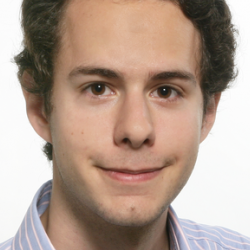Biography
M.Phil. in Physics, University of Cambridge, UK (2014)
Bachelor Thesis, ESPCI ParisTech, France (2013)
B.Sc. in Physics, Universität Konstanz, Germany (2010-2013)
Research
Organic semiconductors exhibit fundamentally different electronic structures than their conventional inorganic counterparts. Charge transport takes place in an energetically disordered landscape where electrons are localized within a few molecules or on a polymer backbone. This results in thermally activated hopping transport and reduced mobilities, typically below 10 cm2/Vs. However, due to their unique physical properties (e.g., formation of triplet excitons, easy manipulation of morphology, long spin-lifetimes) and their tunability by chemical engineering, they can potentially overcome certain limitations found in inorganic semiconductors.
More recently, our group has demonstrated pure spin currents and the inverse spin-hall effect in doped polymers. They show exceptionally long spin lifetimes, owed to very weak spin-orbit coupling in organic materials, and thus are promising candidates for spintronic devices that rely on preserving spin information over long time scales and distances.
In this PhD project, I plan to investigate charge and spin transport in those organic materials through electron spin resonance (ESR) and complementary device measurements. We aim to identify the origin of high mobilities and surprisingly low energetic disorder in an emerging class of amorphous donor-acceptor polymers. ESR measurements grant access to many parameters of polaron dynamics with a high level of detail and at low temperatures, where direct electrical measurements are no longer possible.
In electron spin resonance the resonant absorption of microwaves between spin up and down energy levels in an external magnetic field is measured. It is thus the ideal method to probe a variety of spin-dependent properties as well. Those especially include the strength of spin-orbit coupling, motions frequencies of spins within different domains in the semiconductor and spin relaxation mechanisms with respective lifetimes.
Publications
McNellis, E. R., Schott, S., Sirringhaus, H., and Sinova, J. “Molecular tuning of the magnetic response in organic semiconductors.” Physical Review Materials 2, 074405 (2018).
S. Schott, E. R. McNellis, C. B. Nielsen, H.-Y. Chen, S. Watanabe, H. Tanaka, I. McCulloch, K. Takimiya, J. Sinova, and H. Sirringhaus. “Tuning the effective spin-orbit coupling in molecular semiconductors.” Nat. Comm. 8, 1–10 (2017).
S. Schott, E. Gann, L. Thomsen, S.-H. Jung, J.-K. Lee, C. R. McNeill, and H. Sirringhaus. “Charge-Transport Anisotropy in a Uniaxially Aligned Diketopyrrolopyrrole-Based Copolymer.” Adv. Mater. 27, 7356–7364 (2015).
M. Gruber, S.-H. Jung, S. Schott, D. Venkateshvaran, A. J. Kronemeijer, J. W. Andreasen, C. R. McNeill, W. W. H. Wong, M. Shahid, M. Heeney, J.-K. Lee, and H. Sirringhaus. “Enabling high-mobility, ambipolar charge-transport in a DPP-benzotriazole copolymer by side-chain engineering.” Chem. Sci. 6, 6949–6960 (2015).
S. Schott, J. Bertolotti, J.-F. Léger, L. Bourdieu, and S. Gigan. “Characterization of the angular memory effect of scattered light in biological tissues.” Opt. Express 23, 13505 (2015).


